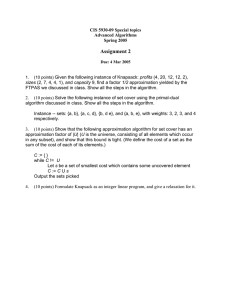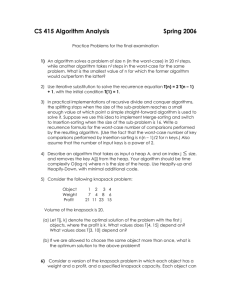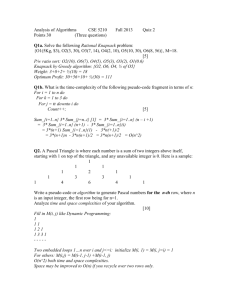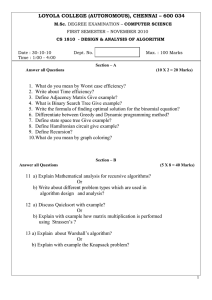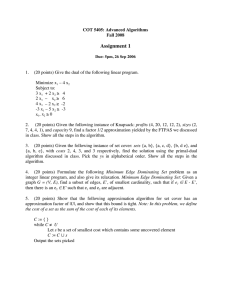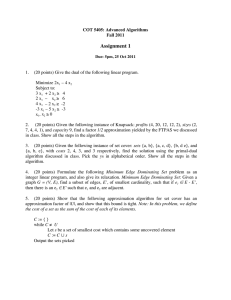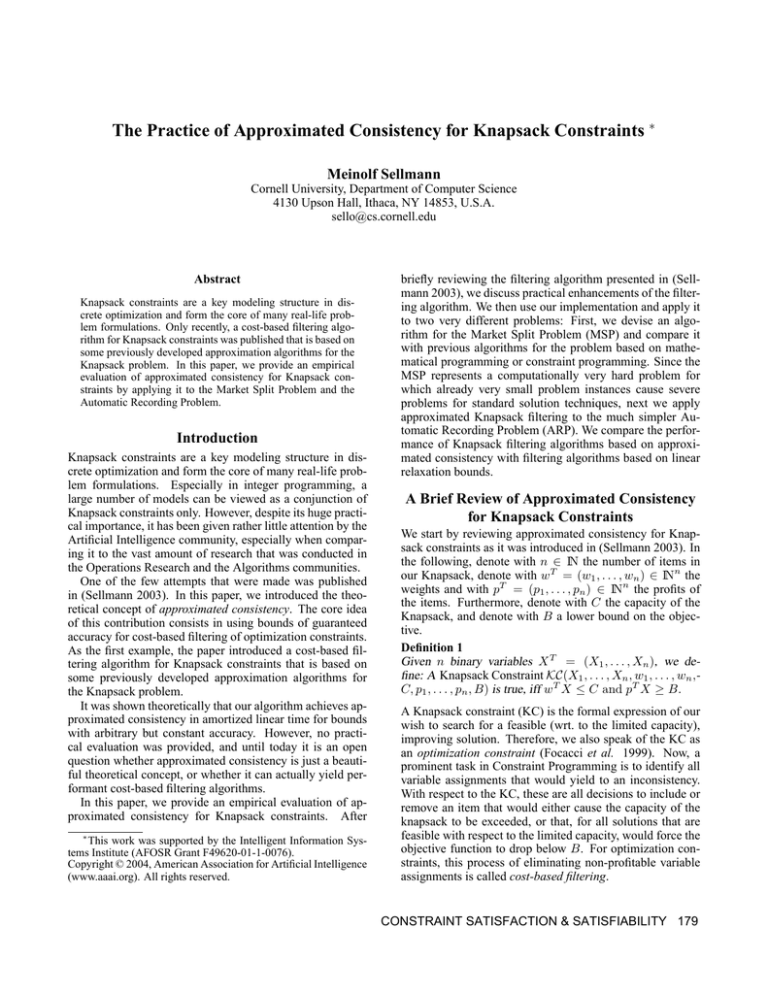
The Practice of Approximated Consistency for Knapsack Constraints ∗
Meinolf Sellmann
Cornell University, Department of Computer Science
4130 Upson Hall, Ithaca, NY 14853, U.S.A.
sello@cs.cornell.edu
Abstract
Knapsack constraints are a key modeling structure in discrete optimization and form the core of many real-life problem formulations. Only recently, a cost-based filtering algorithm for Knapsack constraints was published that is based on
some previously developed approximation algorithms for the
Knapsack problem. In this paper, we provide an empirical
evaluation of approximated consistency for Knapsack constraints by applying it to the Market Split Problem and the
Automatic Recording Problem.
Introduction
Knapsack constraints are a key modeling structure in discrete optimization and form the core of many real-life problem formulations. Especially in integer programming, a
large number of models can be viewed as a conjunction of
Knapsack constraints only. However, despite its huge practical importance, it has been given rather little attention by the
Artificial Intelligence community, especially when comparing it to the vast amount of research that was conducted in
the Operations Research and the Algorithms communities.
One of the few attempts that were made was published
in (Sellmann 2003). In this paper, we introduced the theoretical concept of approximated consistency. The core idea
of this contribution consists in using bounds of guaranteed
accuracy for cost-based filtering of optimization constraints.
As the first example, the paper introduced a cost-based filtering algorithm for Knapsack constraints that is based on
some previously developed approximation algorithms for
the Knapsack problem.
It was shown theoretically that our algorithm achieves approximated consistency in amortized linear time for bounds
with arbitrary but constant accuracy. However, no practical evaluation was provided, and until today it is an open
question whether approximated consistency is just a beautiful theoretical concept, or whether it can actually yield performant cost-based filtering algorithms.
In this paper, we provide an empirical evaluation of approximated consistency for Knapsack constraints. After
∗
This work was supported by the Intelligent Information Systems Institute (AFOSR Grant F49620-01-1-0076).
Copyright © 2004, American Association for Artificial Intelligence
(www.aaai.org). All rights reserved.
briefly reviewing the filtering algorithm presented in (Sellmann 2003), we discuss practical enhancements of the filtering algorithm. We then use our implementation and apply it
to two very different problems: First, we devise an algorithm for the Market Split Problem (MSP) and compare it
with previous algorithms for the problem based on mathematical programming or constraint programming. Since the
MSP represents a computationally very hard problem for
which already very small problem instances cause severe
problems for standard solution techniques, next we apply
approximated Knapsack filtering to the much simpler Automatic Recording Problem (ARP). We compare the performance of Knapsack filtering algorithms based on approximated consistency with filtering algorithms based on linear
relaxation bounds.
A Brief Review of Approximated Consistency
for Knapsack Constraints
We start by reviewing approximated consistency for Knapsack constraints as it was introduced in (Sellmann 2003). In
the following, denote with n ∈ IN the number of items in
our Knapsack, denote with wT = (w1 , . . . , wn ) ∈ INn the
weights and with pT = (p1 , . . . , pn ) ∈ INn the profits of
the items. Furthermore, denote with C the capacity of the
Knapsack, and denote with B a lower bound on the objective.
Definition 1
Given n binary variables X T = (X1 , . . . , Xn ), we define: A Knapsack Constraint KC(X1 , . . . , Xn , w1 , . . . , wn ,C, p1 , . . . , pn , B) is true, iff wT X ≤ C and pT X ≥ B.
A Knapsack constraint (KC) is the formal expression of our
wish to search for a feasible (wrt. to the limited capacity),
improving solution. Therefore, we also speak of the KC as
an optimization constraint (Focacci et al. 1999). Now, a
prominent task in Constraint Programming is to identify all
variable assignments that would yield to an inconsistency.
With respect to the KC, these are all decisions to include or
remove an item that would either cause the capacity of the
knapsack to be exceeded, or that, for all solutions that are
feasible with respect to the limited capacity, would force the
objective function to drop below B. For optimization constraints, this process of eliminating non-profitable variable
assignments is called cost-based filtering.
CONSTRAINT SATISFACTION & SATISFIABILITY 179
Clearly, cost-based filtering for KCs is an NP-hard task,
since it requires the solution of some Knapsack problems
itself. Therefore, we suggested to relax the requirement that
all non-profitable assignments be found and introduced the
notion of approximated consistency:
Definition 2
Denote with KC(X1 , . . . , Xn , w1 , . . . , wn , C, p1 , . . . , pn ,B) a KC where the variables Xi are currently allowed to
take values in Di ⊆ {0, 1}. Then, given some ≥ 0, we say
that KC is -consistent, iff for all 1 ≤ i ≤ n and xi ∈ Di
there exist xj ∈ Dj for all j 6= i such that
X
X
wi xi ≤ C and
pi xi ≥ B − P ∗ ,
i≤n
i≤n
P
P
whereby P ∗ = max{ pi yi | yi ∈ Di ,
wi yi ≤ C}.
Therefore, to achieve a state of -consistency for a KC, we
must ensure that
1. all items are deleted that cannot be part of any solution that obeys the capacity constraint and that achieves
a profit of at least B − P ∗ , and
2. all items have to be permanently inserted into the knapsack that are included in all solutions that obey the capacity constraint and that have a profit of at least B − P ∗ .
That is, we do not enforce that all variable assignments are
filtered that do not yield to any improving solution, but at
least we want to remove all assignments for which the performance is forced to drop too far below the critical objective
value. It is this property of filtering against a bound of guaranteed accuracy (controlled by the parameter ) that distinguishes the filtering algorithms in (Sellmann 2003) from earlier cost-based filtering algorithms for KCs that were based
on linear programming bounds (Fahle and Sellmann 2002).
Of course, it would be nicer if we could use the stronger
bound (1 − )B, but for small lower bound values B we do
not know how to perform filtering based on this bound efficiently. Therefore, the optimal Knapsack value P ∗ is used
in the definition of approximated consistency. In the filtering algorithm, we cannot afford to compute P ∗ of course
(since this would require to solve the Knapsack problem),
but we can nevertheless prove that this bound is achieved
even without computing it exactly.
Now, to achieve a state of -consistency for a KC, we
modified an approximation algorithm for Knapsacks developed in (Lawler 1977). This algorithm works in two steps:
First, the items are partitioned into two sets of large (L)
and small (S) items, whereby L contains all items with
profit larger than some threshold value T . The profits of
the items in L are scaled and rounded down by some factor
K: pL := bpL /Kc.
In the second step, the algorithm computes a solution x =
(xL , xS ) ∈ {0, 1}n (whereby vL and vS contain all entries
of a vector v whose corresponding indices are in L or S,
respectively) such that:
• If an item in S is included in the solution then so are all
items in S that have a higher efficiency (whereby the efficiency of an item is its profit divided by its weight), and
180
CONSTRAINT SATISFACTION & SATISFIABILITY
• KpTL xL + pTS xS is maximized.
If T and K are chosen carefully, the scaling of the profits
of items in L and the additional constraint that a solution can
only include items in S with highest efficiency make it possible to solve this problem in polynomial time. Moreover,
it can be shown that the solution obtained has an objective
value within a factor of (1 − ) from the optimal solution of
the Knapsack that we denoted with P ∗ (Lawler 1977).
The cost-based filtering algorithm makes use of the performance guarantee given by the algorithm. Clearly, if the
solution quality of the approximation under some variable
assignment drops below B − P ∗ , then this assignment cannot be completed to an improving, feasible solution, and it
can be eliminated. We refer the reader to (Sellmann 2003)
for further details on how this elimination process can be
performed efficiently.
Practical Enhancements of the
Filtering Algorithm
The observation that the filtering algorithm is based on the
bound provided by the approximation algorithm is crucial. It
means that, in contrast to the approximation algorithm itself,
we hope to find rather bad solutions by the approximation,
since they provide more accurate bounds on the objective
function. The important task when implementing the filtering algorithm is to estimate the accuracy achieved by the
approximated solution as precisely as possible. For this purpose, in the following we investigate three different aspects:
• the computation of a 2-approximation that is used to determine K and the filtering bound,
• the choice of the scaling factor K, and
• the computation of the filtering bound.
Computation of a 2-Approximation
A 2-approximation on the given Knapsack is used in the approximation algorithm for several purposes. Most importantly, it is used to set the actual filtering bound B. From
our discussion in the previous section it is clear that B can
be set to B − P ∗ . However, we cannot afford to compute
P ∗ since this would require to solve the Knapsack problem
first. Therefore, we showed that it is still correct to filter an
assignment if the performance drops below B − P0 only,
whereby P0 denotes the value of a 2-approximation of the
original Knapsack problem.
The standard procedure for computing a 2-approximation
P0 is to include items with respect to decreasing efficiency.
If an item fits, we insert it, otherwise we leave it out and
consider the following items. After all items have been considered, we compare the solution obtained in that way with
the Knapsack that is obtained when we follow the same procedure but by now considering the items with respect to
decreasing profit (whereby we assume that ||w||∞ ≤ C 1 ).
Then, we choose P0 as the solution that has the larger objective function value. It is easy to prove that this procedure
yields a 2-approximation.
1
||w||∞ denotes the maximum absolute entry of vector w.
Now, with respect to the filtering routine, of course we
would like to set P0 as small as possible. Note that it is
of no relevance for the correctness of the filtering algorithm
that there actually exists a solution that has value P0 . All
that is required is that 2P0 is an upper bound which is indeed
essential for the correctness of our algorithm. Therefore, we
propose to compute the value P0 in a much simpler way.
We can obtain an upper bound by allowing that items can
be inserted fractionally and solving the relaxed problem as a
linear problem. We obtain an upper bound U , and we simply
set P0 := U/2. Is is easy to show that this procedure returns
a value for P0 that is at most as large as the value returned
by the standard 2-approximation algorithm.
tion. To evaluate the practical usefulness of the algorithm,
we first apply it in the context of Market Split Problems
(MSPs), a benchmark that was suggested for Knapsack constraints in (Trick 2001). The original definition goes back
to (Cornuéjols and Dawande 1998; Williams 1978): A large
company has two divisions D1 and D2 . The company supplies retailers with several products. The goal is to allocate
each retailer to either division D1 or D2 so that D1 controls
A% of the company’s market for each product and D2 the
remaining (100-A)%. Formulated as an integer program, the
problem reads:
P
P
A
= 100
∀0≤i<m
j aij xj
j aij
xj ∈ {0, 1}
∀ 0 ≤ j < n,
Setting the Scaling Factor
whereby m denotes the number of products, n is the number
of retailers, and aij is the demand of retailer j of product i.
The next issue regards the factor with which the profits in
the set of large items L are scaled down. According to the
correctness proof in (Sellmann 2003), we need to ensure that
K T ∗
T
∗
∗
T pL xL +pS (xS −xS ) ≤ P0 , whereby x denotes an optimal solution to the Knapsack problem, and x denotes the solution found by our approximation algorithm. We proposed
to set K := 4 T . Intuitively, we obtain worse approximation
results (and consequently more accurate upper bounds) and
shorter running times if we scale the profits of the items in L
as much as possible. We can choose the scaling factor more
P0
aggressively, by setting K := 2U
T , where UL denotes an
L
upper bound on the large item Knapsack problem. Then, it
holds that:
P0 pTL x∗L
P0
K T ∗
pL xL + pTS (x∗S − xS ) ≤
+
≤ P0 .
T
2 UL
2
Therefore, our setting maintains correctness. In order to
compute UL we use the linear programming upper bound
on the large item problem. Nota bene: If UL = 0, the large
item problem is trivially solved by the empty Knapsack, and
we do not need to scale the profits at all.
Setting the Filtering Bound
The last important issue regards the bound against which
we filter eventually. In the analysis of the approximation
algorithm both the large and the small item problem contribute equally to the approximation error made. More precisely, the large item problem contributes an error of P20 ,
and the small item problem contributes ||pS ||∞ . When setting T := P20 , clearly the total deviation from the optimum
is bounded by P0 . Consequently, we proposed to set the
filtering bound to B := B − P0 . With respect to the brief
discussion above, we can already enhance on this by setting
B := B − P20 − ||pS ||∞ . Like that, if the small item problem is actually empty, we are able to half the absolute error
made! Similarly, if the large item problem is empty, or if
UL = 0, this problem does not contribute to the error made.
Then we can even set B := B − ||pS ||∞ .
Approximated Knapsack Filtering for
Market Split Problems
We implemented the approximated filtering algorithm including the enhancements discussed in the previous sec-
A Tree-Search-Algorithm for the MSP
We model the problem as a constraint program by introducing one Knapsack constraint for each product, whereby
profit and weight of each Knapsack item are equal. Capacity
and profit bound are determined by the right hand side of the
constraint. Following an idea presented in (Trick 2001), additionally we add one more redundant Knapsack constraint
that is the weighted sum of the other constraints:
P iP
P i A P
=
j aij
iλ
j aij xj
i λ 100
xj ∈ {0, 1}
∀ 0 ≤ j < n.
In (Trick 2001) it was conjectured that, if λ was chosen large
enough, the summed-up constraint contained the same set of
solutions as the conjunction of Knapsack constraints. This
is true for Knapsack constraints as they evolve in the context
of the MSP where the weight and the profit of each item are
the same and capacity and profit bound are matching. However, the example 3 ≤ 2x1 + 7x2 ≤ 8 in combination with
3 ≤ 7x1 + 2x2 ≤ 8, x1 , x2 ∈ {0, 1}, shows that this is
not true in general: The conjunction of both Knapsack constraints is clearly infeasible, yet no matter how we set λ, no
summed-up constraint alone is able to reveal this fact. Note
that, when setting λ to a very large value in the summed-up
constraint, the profit becomes very large, too. Consequently,
the absolute error made by the approximation algorithm becomes larger, too, and thereby renders the filtering algorithm
less effective. In accordance to Trick’s report, we found that
λ = 5 yields very good filtering results for the CornuéjolsDawande MSP instances that we consider in our experimentation.
Using the model as discussed above, our algorithm for
solving the MSP carries out a tree-search. In every choice
point, the Knapsack constraints perform cost-based filtering, exchanging information about removed and included
items. On top of that, we perform cost-based filtering by
changing the capacity constraints within the Knapsack constraints. As Trick had noted in his paper already, the weights
of the items and the capacity of the Knapsack can easily
be modified once a Knapsack constraint is initialized. The
new weight constraints considered are the capacity and profit
constraints of the other Knapsack constraints as well as additional weighted sums of the original capacity constraints,
CONSTRAINT SATISFACTION & SATISFIABILITY 181
max
φ
min
max
2%
φ
min
max
1%
φ
min
max
5‰
φ
min
max
2‰
φ
min
max
1‰
φ
min
max
0.5‰ φ
min
5%
# Constraints / # Variables – % Feasible
3 / 20 – 8% 4 / 30 – 29%
5 / 40 – 34%
CPs Time CPs Time
CPs
Time
11 0.18 8699 211.8
3.53 0.08 1392 50.21
1
0.04
7
1.04
3
0.07
321 31.53 505K 52.6K
1.29 0.03 26.71 4.92 30.1K 4867
1
0.01
3
0.98
96
36.2
3
0.05
19
7.68 26.8K 12.6K
1.25 0.03
2.7
0.68
943.3 552.8
1
0.01
1
0.41
25
38.85
3
0.05
7
0.99
171
826.8
1.25 0.03
2.61 0.61
60.15 174.9
1
0.02
1
0.42
5
30.96
3
0.04
7
0.96
59
47.19
1.25 0.03
2.61 0.61
13.9 28.99
1
0.01
1
0.43
3
16.08
3
0.05
7
0.95
59
47.75
1.25 0.03
2.61 0.61
13.9 28.98
1
0.01
1
0.34
3
16.19
7
0.95
59
47.8
2.61 0.61
13.9 28.98
1
0.44
3
16.13
Table 1: Numerical results for our 3 benchmark sets. Each
set contains 100 Cornuéjols-Dawande instances, and the percentage of feasible solutions in each set is given. We apply our MSP algorithm varying the approximation guarantee for the Knapsack filtering algorithm between 5% and
0.5‰. For each benchmark set, we report the maximum, average, and minimum number of choice points and computation time in seconds.
whereby we use as weights powers of λ = 5 again while
considering the original constraints in random order. After
the cost-based filtering phase, we branch by choosing a random item that is still undecided yet and continue our search
in a depth-first manner.
Numerical Results for the MSP
All experiments in this paper were conducted on an AMD
Athlontm 1.2 GHz Processor with 500 MByte RAM running
Linux 2.4.10, and we used the gnu C++ compiler version
g++ 2.91.
(Cornuéjols and Dawande 1998) generated computationally very hard random MSP instances by setting n :=
10(m − 1), choosing the aij randomly from the interval
{0, . . . , 99}, and setting A := 50%. We use their method
to generate 3 benchmark sets containing 3 products (constraints) and 20 retailers (variables), 4 constraints and 30
variables, and 5 constraints and 40 variables. Each set contains 100 random instances. In Table 1 we report our numerical results.
As our results show, the choice of has a severe impact
on the performance of our algorithm. We see that for the
benchmark set (3,20) it is completely sufficient to set :=
0.02. However, even for these very small problem instances,
setting to 5% almost triples the average number of choice
points and computation time. On the other hand, choosing
a better approximation guarantee does not improve on the
182
CONSTRAINT SATISFACTION & SATISFIABILITY
performance of the algorithm anymore. We get a similar
picture when looking at the other benchmark sets, but shifted
to a different scale: For the set (4,30), the best performance
can be achieved when setting := 5‰, for the set (5,40) this
value even decreases to 2‰.
In our experiments, we found that choosing higher approximation accuracies can sometimes yield an increase in
the number of choice points. This counter intuitive effect is
explained by the fact that the approximated filtering algorithm is not monotone in the sense that demanding higher
accuracy does not automatically result in better bounds. It
may happen occasionally that for a demanded accuracy of
5‰ the approximation algorithm does a rather poor job
which results in very tight bound on the objective function.
Now, when demanding an accuracy of 1‰ , the approximation algorithm may actually compute the optimal solution,
thus yielding a bound that can be up to 1‰ away from the
correct value. Consequently, by demanding higher accuracy
we may actually get a lower one in practice.
When comparing the absolute running times with other
results on the Cornuéjols-Dawande instances reported in the
literature, we find that approximated consistency is doing a
remarkably good job: Comparing the results with those reported in (Trick 2001), we find that approximated Knapsack
filtering even outperforms the generate-and-test method on
the (4,30) benchmark. Note that this method is probably
not suitable for tackling larger problem instances, while approximated consistency allows us to scale this limit up to 5
constraints and 40 variables.
When comparing our MSP algorithm with the best algorithm that exists for this problem (Aardal et al. 1999), we
find that, for the (4,30) and the (5,40) benchmark sets, we
achieve competitive running times. This is a very remarkable result, since really approximated Knapsack filtering is
in no way limited or special to Market Split Problems. It
could for example also be used to tackle slightly different
and more realistic problems in which a splitting range is
specified rather than an exact percentage on how the market is to be partitioned. And of course, it can also be used
when the profit of the items does not match their weight and
in any context where Knapsack constraints occur.
We also tried to apply our algorithm to another benchmark set with 6 constraints and 50 variables. For this set,
we were not able to experiment with values for that are below 5‰ since then the memory requirements of the filtering
algorithm were exceeding the available RAM. We therefore
note that the comparably high memory requirements present
a clear limitation of the practical use of the approximated filtering routine. Still, the (6,50)-instances can be solved with
our approach, but this takes a few hours on average. That
this is possible at all is a direct merit of the improvements
that we suggested in the previous section. Unfortunately,
there is not space enough to present a detailed evaluation
here. So we just note our improvements reduce the memory requirements and the accuracy of the algorithm considerably.
It remains to note that our experimentation also confirms a
result from (Aardal et al. 1999) regarding the probability of
generating infeasible solutions by the Cornuéjols-Dawande
method. Clearly, the number of feasible instances increases
the more constraints and variables are considered by their
generator. For a detailed study on where the actual phasetransition for Market Split Problems is probably located, we
refer the reader to the Aardal paper.
Approximated Knapsack Filtering for the
Automatic Recording Problem
Encouraged by the surprisingly good numerical results on
the MSP, we want to evaluate the use of approximated consistency in the context of a very different application problem that incorporates a Knapsack constraint in combination
with other constraints. We consider the Automatic Recording Problem (ARP) that was introduced in (Sellmann and
Fahle 2003):
The technology of digital television offers to hide metadata in the content stream. For example, an electronic program guide with broadcasting times and program annotation
can be transmitted. An intelligent video recorder like the
TIVOtm system (TIVO ) can exploit this information and automatically record TV content that matches the profile of the
system’s user. Given a profit value for each program within
a predefined planning horizon, the system has to make the
choice which programs shall be recorded, whereby two restrictions have to be met:
• The disk capacity of the recorder must not be exceeded.
• Only one program can be recorded at a time.
CP-based Lagrangian Relaxation for the ARP
Like in (Sellmann and Fahle 2003), we use an approach
featuring CP-based Lagrangian relaxation: The algorithm
performs a tree search, filtering out assignments, in every
choice point, with respect to a Knapsack constraint (capturing the limited disk space requirement) and a weighted stable set constraint on an interval graph (that ensures that only
temporally non-overlapping programs are recorded).
For the experiments, we compare two variants of this algorithm: The first uses approximated Knapsack filtering,
the second a cost-based filtering method for Knapsack constraints that is based on linear relaxation bounds (Fahle and
Sellmann 2002). While CP-based Lagrangian relaxation
leaves the weight constraint unmodified but calls to the filtering routine with ever changing profit constraints, we replace,
in the Knapsack constraint, each variable xi by yi = 1 − xi .
Thereby, profit and weight constraint change roles and we
can apply the technique in (Trick 2001) again by calling the
approximated Knapsack filtering routine with different capacity constraints.
Numerical Results for the ARP
For our experiments, we use a benchmark set that we made
accessible to the research community in (ARP 2004). This
benchmark was generated using the same generator that was
used for the experimentation in (Sellmann and Fahle 2003):
Each set of instances is generated by specifying the time
horizon (half a day or a full day) and the number of channels (20 or 50). The generator sequentially fills the channels
by starting each new program one minute after the last. For
each new program, a class is being chosen randomly. That
class then determines the interval from which the length
is chosen randomly. The generator considers 5 different
classes. The lengths of programs in the classes vary from
5±2 minutes to 150±50 minutes. The disk space necessary
to store each program equals its length, and the storage capacity is randomly chosen as 45%–55% of the entire time
horizon.
To achieve a complete instance, it remains to choose the
associated profits of programs. Four different strategies for
the computation of an objective function are available:
• For the class usefulness (CU) instances, the associated
profit values are determined with respect to the chosen
class, where the associated profit values of a class can vary
between zero and 600±200.
• In the time strongly correlated (TSC) instances, each 15
minute time interval is assigned a random value between
0 and 10. Then the profit of a program is determined as
the sum of all intervals that program has a non-empty intersection with.
• For the time weakly correlated (TWC) instances, that
value is perturbed by a noise of ±20%.
• Finally, in the strongly correlated (SC) data, the profit of
a program simply equals its length.
Table 2 shows our numerical results. We apply our ARP
algorithm using approximated consistency for cost-based filtering and vary between 5% and 5‰. We compare the
number of choice points and the time needed by this method
with a variant of our ARP algorithm that uses Knapsack filtering based on linear relaxation bounds instead of approximated consistency. The numbers reported are the average
and (in brackets) the median relative performance for each
set containing 10 randomly generated instances.
Consider as an example the set containing instances with
50 channels and a planning horizon of 1440 minutes where
the profit values have been generated according to method
TWC. According to Table 2, the variant of our algorithm using approximated consistency with accuracy = 5% visits
72.79% of the number of choice points that the variant incorporating linear programming bounds is exploring. However,
when comparing the time needed, we see that approximated
consistency actually takes 178.80% of the time, clearly because the time per choice point is higher compared to the
linear programming variant.
Looking at the table as a whole, this observation holds for
the entire benchmark set: even when approximated consistency is able to reduce the number of choice points significantly (as it is the case for the TWC and TSC instances),
the effort is never (!) worthwhile. On the contrary, the approximation variant is, on average, 30% up to almost 5 times
slower than the algorithm using linear bounds for filtering.
In this context it is also remarkable that, in general, a variation of the approximation guarantee had no significant effect on the number of choice points visited. This effect is
caused by the fact that an improvement on the Knapsack side
need not necessarily improve the global Lagrangian bound.
CONSTRAINT SATISFACTION & SATISFIABILITY 183
#channels/
φ
horizon
# progs
20/720
305.3
CU
50/720
771.3
20/1440
609.8
50/1440
1440
20/720
317.5
SC
50/720
788.5
20/1440
609.9
50/1440
1464
20/720
305.3
TWC
50/720
771.3
20/1440
609.8
50/1440
1440
20/720
307.2
TSC
50/720
780.8
20/1440
609.8
50/1440
1448
obj.
Time
(sec)
14.3
58.7
67.8
2426
4.3
2.1
4.1
1.8
15.2
60.8
207.0
71.2
35.5
681
239.5
7295
= 5%
CPs (%)
Time (%)
99.7 (104.6) 163.6 (153.6)
101.5 (100.3) 168.5 (169.0)
97.2 (99.0) 193.3 (195.5)
118.1 (110.3) 165.2 (143.0)
138.8 (122.5) 199.2 (125.8)
137.3 (128.9) 250.1 (242.3)
124.8 (114.2) 256.6 (317.5)
108.9 (108.3) 278.2 (365.7)
92.6 (94.1) 212.9 (249.5)
72.8 (76.7) 178.8 (181.1)
83.4 (83.7) 189.4 (189.5)
77.5 (80.2) 177.3 (181.4)
71.2 (71.4) 199.3 (182.6)
84.7 (87.3) 144.5 (133.1)
82.6 (85.2) 172.0 (171.5)
91.9 (98.4) 134.6 (128.0)
= 1%
CPs (%)
Time (%)
99.7 (104.6) 235.0 (224.6)
101.5 (100.3) 169.6 (170.9)
97.2 (99.0) 234.5 (235.3)
118.1 (110.3) 165.2 (140.9)
138.8 (122.5) 157.1 (541.9)
137.3 (128.9) 251.2 (245.0)
124.8 (114.2) 132.7 (595.2)
108.9 (108.3) 280.9 (371.3)
92.5 (94.1) 314.3 (340.6)
72.8 (76.7) 181.5 (184.3)
83.4 (83.7) 325.4 (297.7)
77.5 (80.2) 177.9 (181.9)
71.2 (71.4) 286.4 (268.9)
84.7 (87.3) 141.5 (131.7)
82.6 (85.2) 267.0 (248.8)
91.9 (98.4) 134.7 (128.0)
= 5‰
CPs (%)
Time (%)
99.7 (104.6) 291.9 (280.0)
101.5 (100.3) 227.9 (217.4)
97.2 (99.0) 359.7 (358.9)
112.2 (105.4) 165.9 (134.7)
138.8 (122.5) 236.4 (1093.7)
137.3 (128.9) 171.9 (732.9)
124.8 (114.2) 324.3 (1683.6)
108.9 (108.3) 302.7 (405.2)
92.0 (94.1) 420.7 (388.0)
72.8 (76.7) 298.1 (288.6)
83.4 (83.7) 217.4 (538.8)
77.5 (80.2) 205.0 (206.8)
69.4 (71.4) 385.5 (370.3)
84.7 (87.3) 192.0 (182.5)
82.6 (85.2) 480.3 (467.6)
91.9 (98.4) 140.6 (134.5)
Table 2: Numerical results for the ARP benchmark. We apply our algorithm varying the approximation guarantee of the Knapsack filtering algorithm between 5% and 5‰. The first two columns specify the settings of the random benchmark generator:
the first value denotes the objective variant taken, and it is followed by the number of TV channels and the planning time
horizon in minutes. Each set identified by these parameters contains 10 instances, the average number of programs per set is
given in the third column. We report the average (median) factor (in %) that the approximation variant needs relative to the
variant using Knapsack filtering based on linear relaxation bounds. The average absolute time (in seconds) of the last algorithm
is given in the fourth column.
It clearly depends on the application when a more accurate
filtering of the Knapsack constraint pays off for the overall
problem.
Conclusions
The most important advantage of approximated consistency
is our ability to trade filtering efficiency for computation
time. It would be most interesting to have a general understanding of this trade-off that would allow us to develop
automated strategies for tuning the filtering effectiveness towards problems and problem instances.
Our numerical evaluation shows that manually tuned approximated consistency for Knapsack constraints can lead to
massive improvements for critically constrained problems.
Approximated consistency is the first generic constraint programming approach that can efficiently tackle the Market
Split Problem (MSP), and is even competitive when compared with specialized state-of-the-art approaches for this
problem. Note that, for the Knapsack constraints as they
evolve from the MSP where profit and weight of each item
are the same, linear relaxation bounds are in most cases
meaningless, thus rendering Knapsack filtering based on
these bounds without effect.
On the other hand, the application to the Automatic
Recording Problem showed that, for combined problems,
the effectiveness of a more accurate Knapsack filtering
can be limited by the strength of the global bound that is
achieved. The practical use of approximated filtering is further limited by high memory requirements for very tight approximation guarantees. And for lower accuracies, Knapsack filtering based on linear relaxation bounds may be almost as effective and overall faster.
184
CONSTRAINT SATISFACTION & SATISFIABILITY
References
K. Aardal, R.E. Bixby, C.A.J. Hurkens, A.K. Lenstra,
J.W. Smeltink. Market Split and Basis Reduction: Towards
a Solution of the Cornuéjols-Dawande Instances. IPCO,
Springer LNCS 1610:1–16, 1999.
ARP: A Benchmark Set for the Automatic Recording Problem,
maintained by M. Sellmann,
http://www.cs.cornell.edu/∼sello/arp benchmark.tar.gz
G. Cornuéjols, M. Dawande. A Class of Hard Small 0-1
Programs. IPCO, Springer LNCS 1412:284–293, 1998.
T. Fahle, M. Sellmann. Cost-Based Filtering for the Constrained Knapsack Problem. AOR, 115:73–93, 2002.
F. Focacci, A. Lodi, M. Milano. Cost-Based Domain Filtering. CP, Springer LNCS 1713:189–203, 1999.
E.L. Lawler. Fast Approximation Algorithm for Knapsack
Problems. FOCS, pp. 206–213, 1977.
M. Sellmann. Approximated Consistency for Knapsack
Constraints. CP, Springer LNCS 2833: 679–693, 2003.
M. Sellmann and T. Fahle. Constraint Programming Based
Lagrangian Relaxation for the Automatic Recording Problem. AOR, 118:17–33, 2003.
TIVO.
TV your way.
TIVO, Inc., http://www.tivo.com/home.asp.
M. Trick. A Dynamic Programming Approach for Consistency and Propagation for Knapsack Constraints. CP-AIOR’01, pp. 113–124, 2001.
H.P. Williams. Model Building in Mathematical Programming. Wiley, 1978.

